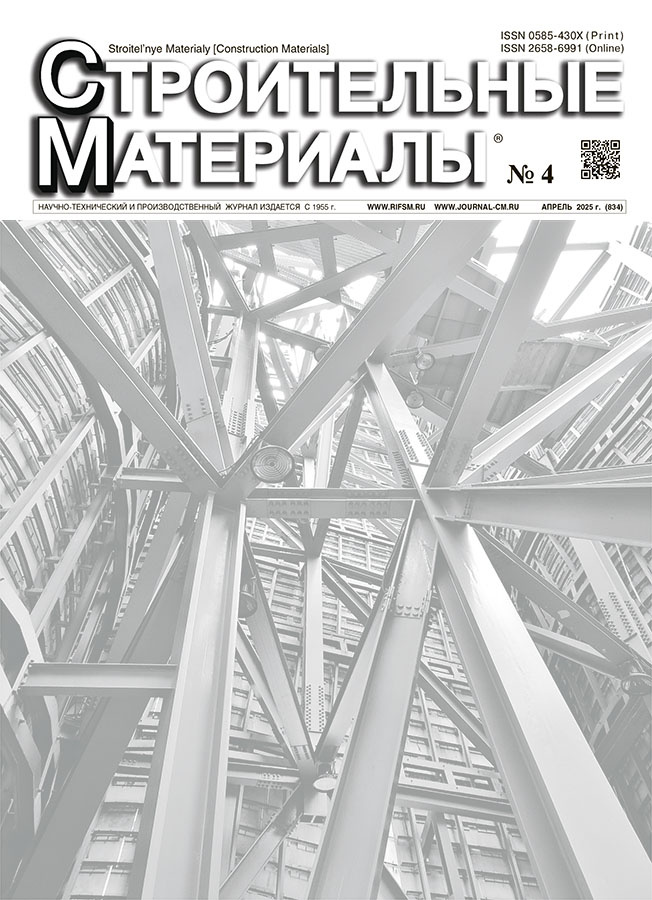Influence of clay shale and quartz sand on the ceramic masses molding properties in soft molding
- Autores: Kotlyar V.D.1, Nebezhko Y.I.1, Dyachenko N.E.1
-
Afiliações:
- Don State Technical University
- Edição: Nº 4 (2025)
- Páginas: 52-58
- Seção: Статьи
- URL: https://rjonco.com/0585-430X/article/view/682910
- DOI: https://doi.org/10.31659/0585-430X-2025-834-4-52-58
- ID: 682910
Citar
Texto integral
Resumo
In recent years, soft molding method of ceramic face bricks production has been increasingly implemented. This method allows making bricks with special decorative effects that unattainable for other molding methods, which makes the products very popular on the market. The peculiarity of this method is the molding masses increased water content in comparison with the plastic method and reduced water content in comparison with identical mass composition casting. Conventionally four soft molding bricks manufacturing technological methods can be distinguished. These are the actual manual products molding, the workpiece casting or overclocking molding method, the crushing method and the vibration forming method. For selecting raw material compositions a special approach to their molding properties assessment is required, including the additional indicators determination: the samples deformation degree, the critical compression stress, adhesiveness, as well as the elastic-plastic-viscous characteristics (plasticity, elasticity, the true relaxation period, etc.). The structural and mechanical properties are determined by the chemical and mineralogical composition and the molding masses structure. There are still few practical developments in the field of the soft molding. The article presents the study results of the clay shales and quartz sand (as leaners) effect of various grain compositions on the ceramic masses molding properties of soft molding. It has been found that for typical polymineral clays, at optimal humidity (≈ 20-25%), the clay shales or quartz sand addition of up to 50% reduce the masses critical compression stress by 20 times. It makes possible to apply soft molding various methods and create a variety of the brick front faces reliefs without increasing the water content of the molding masses.
Palavras-chave
Texto integral
Sobre autores
V. Kotlyar
Don State Technical University
Autor responsável pela correspondência
Email: diatomit_kvd@mail.ru
Doctor of Sciences (Engineering), Professor
Rússia, 1, Gagarin Square, Rostov-on-Don, 344010Yu. Nebezhko
Don State Technical University
Email: ceramic_nyi@mail.ru
Engineer, Postgraduate Student
Rússia, 1, Gagarin Square, Rostov-on-Don, 344010N. Dyachenko
Don State Technical University
Email: dia4encko.nikit@yandex.ru
Postgraduate Student
Rússia, 1, Gagarin Square, Rostov-on-Don, 344010Bibliografia
- Nebezhko Yu.I., Lapunova K.A. (2023). Features of the front surface of soft-molded ceramic brick. “Construction Materials Science: Present and Future”Ж Materials of the III All-Russian Scientific Conference. Moscow, November 15–16, 2023, National Research University Moscow State University of Civil Engineering. Vol. 1, pp. 204–210. (In Russian). https://mgsu.ru/resources/izdatelskaya-deyatelnost/izdaniya/izdaniya-otkr-dostupa/2023/Sbornik_Stroy-material__2023.pdf
- Meskhi B.Ch., Bozhko Yu.A., Terekhina Yu.V., Lapunova K.A. (2020). Brick-design and its main elements. Stroitel’nye Materialy [Construction Materials]. 2020. No. 8, pp. 47–51. (In Russian). EDN: BKBXAY. https://doi.org/10.31659/0585-430X-2020-783-8-47-51
- Goncharov Yu.I. Syrevyye materialy silikatnoy promyshlennosti [Raw materials of the silicate industry]. Moscow: ASV. 2009. 124 p.
- Kraynov A.V., Dmitriev D.A. (2017). Mineral and raw material base of refractory and refractory clays of the Central Chernozem region and prospects for its development. Vestnik of Voronezh State University. Series: Geology. 2017. No. 4, pp. 79–85. (In Russian). EDN: ZWGUGP
- Talpa B.V., Kotlyar A.V. Mineral and Raw Material Base of Lithified Clay Rocks in the South of Russia for the Production of Building Ceramics. Stroitel’nye Materialy [Construction Materials]. 2015. No. 4, pp. 31–33. (In Russian). EDN: TQATXR
- Metodicheskiye rekomendatsii po primeneniyu Klassifikatsii zapasov mestor Natural Resources Moscow: FGU GKZ. 2007. 37 p.
- Frolov V.T. Litologiya [Lithology]. Book 2. Moscow: Moscow State University. 1993. 432 p.
- Kotlyar A.V. Characteristics of Stone-Like Clay Rocks as Raw Materials for the Production of Building Ceramics. Stroitel’nye Materialy [Construction Materials]. 2022. No. 4, pp. 31–37. (In Russian). EDN: WMTHIR. https://doi.org/10.31659/0585-430X-2022-801-4-31-37
- Kondratenko V.A. Keramicheskiye stenovyye materialy: optimizatsiya ikh fiziko-tekhnicheskikh svoystv i tekhnologicheskikh parametrov proizvodstva [Ceramic wall materials: optimization of their physical and technical properties and production technological parameters]. Moscow: Kompozit. 2005. 509 p.
- Guzman I.Yu. et al. Khimicheskaya tekhnologiya keramiki [Chemical technology of ceramics]. Moscow: RIF “Stroymaterialy”, 2003. 496 p.
- Ezerskiy V.A. Research of clays for the production of ceramic brick and tiles. Stroitel’nye Materialy [Construction Materials]. 2002. No. 3, pp. 48–50. (In Russian). EDN: IBEEDT
- Kotlyar V.D., Nebezhko Yu.I., Semenova M.Yu. Molding properties of clay mixtures in the soft mud brick manufacture. Stroitel’nye Materialy i Izdeliya [Construction Materials and Products]. 2024. Vol. 7 (1), 5 (In Russian). https://doi.org/10.58224/2618-7183-2024-7-1-5
- Rakhimova G., Stolboushkin A., Vyshar O., Stanevich V., Rakhimov M., Kozlov P. Strong Structure Formation of Ceramic Composites Based on Coal Mining Overburden Rocks. Journal of Composites Science. 2023. 7 (5), 209. https://doi.org/10.3390/jcs7050209
Arquivos suplementares



















